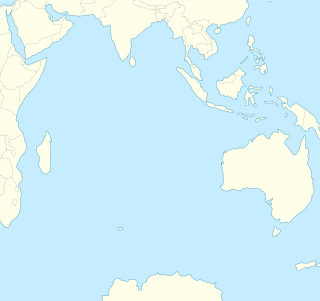
Meade Island is an uninhabited sand island located about 200 metres from Dirk Hartog Island in the Shark Bay World Heritage Site in Western Australia, and joined to that island at low tide. It has an area of about 800 square metres, and an elevation of two metres (7 ft).

Grevillea obtusifolia, the obtuse-leaved grevillea, is a shrub which is endemic to the south-west of Western Australia. It grows up to between 0.5 and 1.5 metres in height and up to 5 metres in width. It produces pink to red flowers between August and November in its native range.

Acacia truncata, commonly known as the angle leaved wattle or west coast wattle, is a coastal shrub in the family Fabaceae, with a native distribution along the southwest coast of Western Australia. A specimen of this wattle was part of an early European botanical collection, perhaps the first from Australia.

Scaevola aemula, the fairy fan-flower or common fan-flower, is a small shrub in the family Goodeniaceae, native to southern Australia. It grows to 50 cm in height and produces white or blue flowers in spikes up to 24 cm long from August to March in its native range. These are followed by rounded, wrinkled berries to 4.5 mm in length.

Grevillea diversifolia, the variable-leaved grevillea, is a shrub in the family Proteaceae. It is endemic to the south-west of Western Australia. It has an erect or spreading shrub habit, growing to between 1 and 5 metres in height and has a peak flowering period between July and October in its native range.

Scaevola platyphylla, commonly known as broad-leaved fanflower, is a shrub in the family Goodeniaceae. It is endemic to the south-west of Western Australia. Plants grow to between 0.3 and 1.3 metres high and have blue to purple flowers that appear between August and January in their native range.
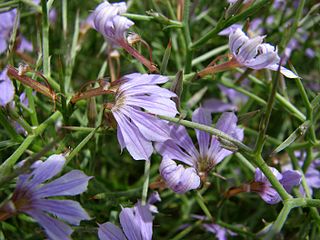
Scaevola oxyclona, commonly known as tangled fanflower, is a spiny shrub in the family Goodeniaceae, native to Western Australia. It grows to between 0.1 and 1.5 metres high and produces blue to purple flowers from August to December in its native range. The species was first formally described in 1876 by Victorian Government Botanist Ferdinand von Mueller in the tenth volume of Fragmenta Phytographiae Australiae based on plant material collected at Frasers Range and Mount Benjamin.

Hibbertia serrata, commonly known as serrate-leaved guinea-flower, is a shrub that is endemic to the south-west of Western Australia. It grows to between 0.1 and 2 metres high and has yellow flowers which appear between August and December in the species' native range.
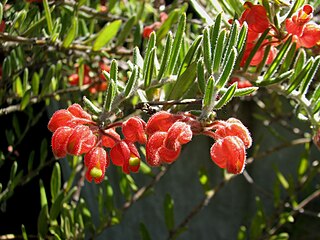
Grevillea saccata, commonly known as pouched grevillea, is a shrub which is endemic to the south-west region of Western Australia. It grows to between 0.25 and 0.5 metres in height. The red flowers usually appear from June to November in the species' native range. The species was formally described in 1870 by English botanist George Bentham in his Flora Australiensis.
Baeckea crassifolia, commonly known as the desert heath-myrtle or the desert baeckea, is a common heathland shrub found in coastal areas of southern Australia.
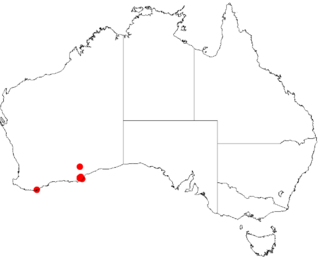
Scaevola brookeana, or heart-leaved fan-flower, is a shrub in the family Goodeniaceae, native to Western Australia. It grows to between 0.2 and 0.7 metres high and produces white or blue flowers from August to December in its native range. The species was formally described by Victorian Government Botanist Ferdinand von Mueller in the tenth volume of Fragmenta Phytographiae Australiae based on plant material collected by Sarah Brooks, after whom it is named.
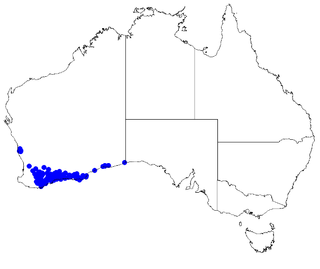
Boronia crassifolia is a plant in the citrus family, Rutaceae and is endemic to the south-west of Western Australia. It is a small, slender shrub with pinnate leaves, and yellowish green to brownish, four petalled flowers.

Scaevola acacioides, is an erect, spreading shrub in the Goodeniaceae family.

Scaevola spinescens is a shrub in the Goodeniaceae family, found in all mainland Australian states and territories, in the drier parts.

Scaevola nitida is an erect shrub in the Goodeniaceae family, native to Western Australia. It grows to a height of 0.3 to 3 m, and its blue-purple flowers may be seen from August to December.

Scaevola humifusa is a prostrate shrub in the Goodeniaceae family, native to Western Australia. It grows to a height of 0.01 to 0.5 m, and its white-cream/white-blue flowers may be seen from August to November or January.

Scaevola parvifolia is an erect, many stemmed perennial in the Goodeniaceae family, which is native to Western Australia, the Northern Territory, Queensland and South Australia. It grows to a height of 0.6 m, and its blue-purple flowers may be seen from March to October.
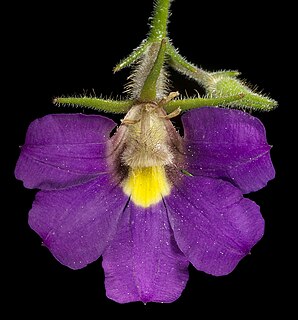
Scaevola phlebopetala, commonly known as velvet fanflower, is a herb in the Goodeniaceae family and is endemic to Western Australia.

Scaevola repens is a shrub in the family Goodeniaceae, endemic to the south west of Western Australia.



















